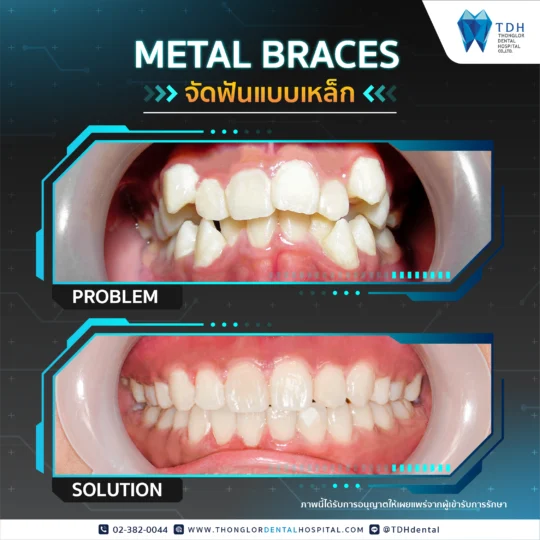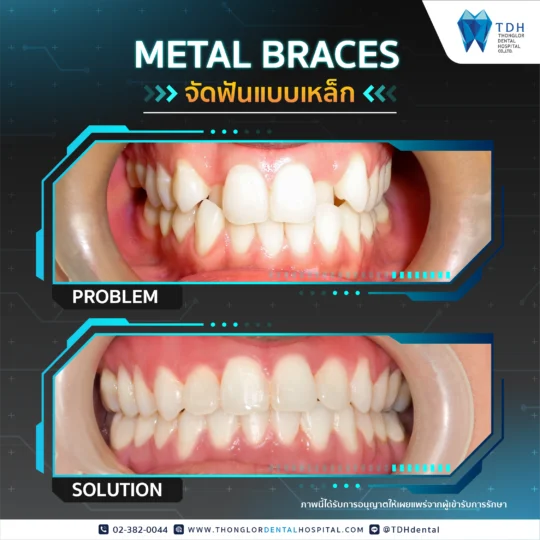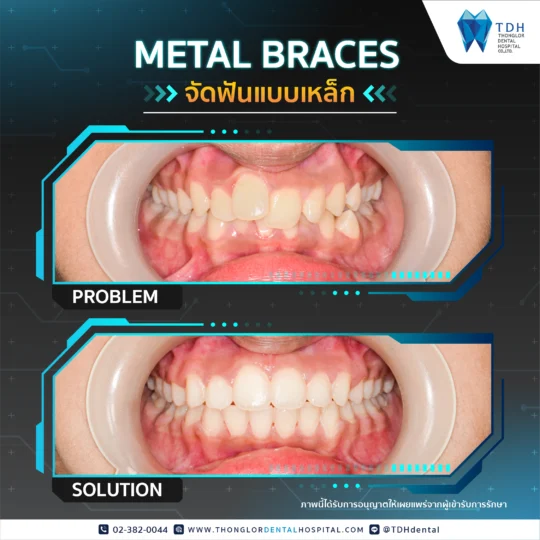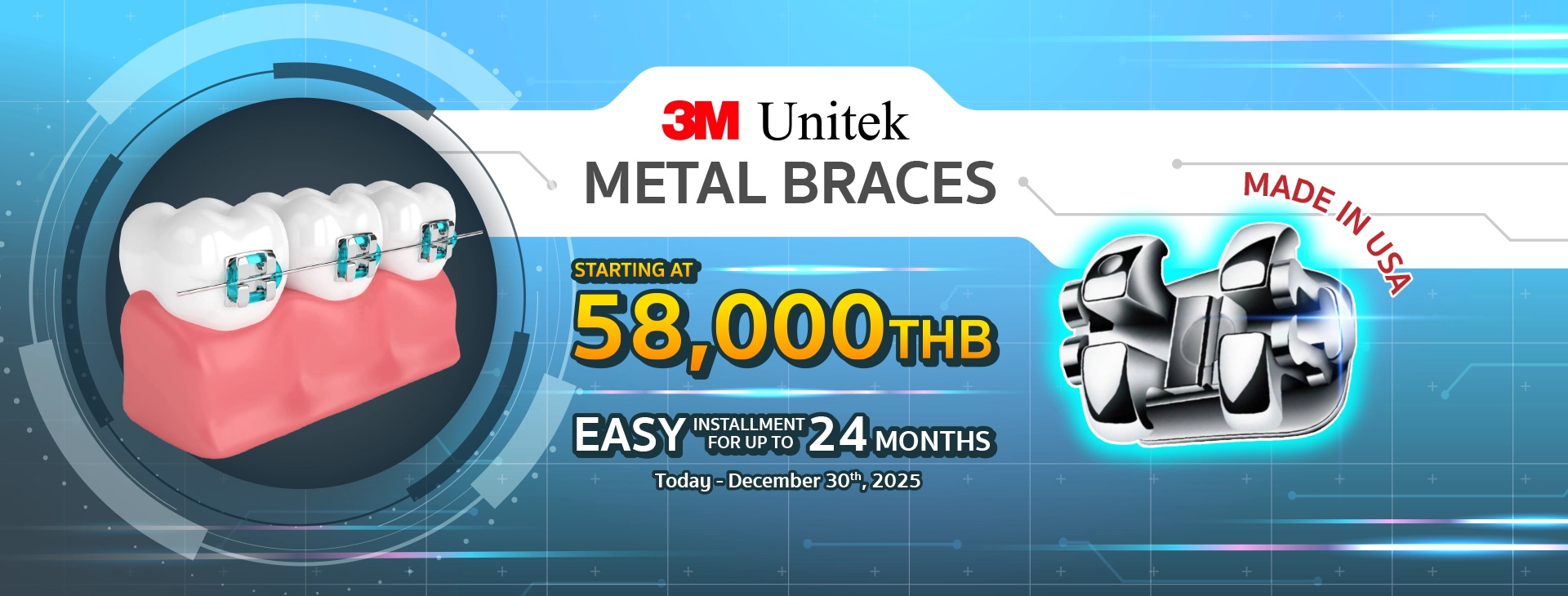
What are metal braces?
Metal braces are widely popular. Currently, the materials used have been developed to be smaller, more efficient, and more comfortable. The advantage is that they can be used for all types of braces at a cheaper price than other types, including a variety of colors of rubber bands to choose from.
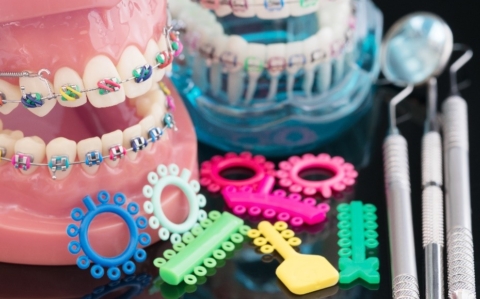
1. Gap between teeth
Causes: Continuous abnormal growth of the jawbone and differences in tooth size. When a tooth is missing, it can cause the adjacent teeth to move into the missing space.
Consequences: Gaps between the teeth can lead to gum disease (because there are no teeth to protect them), deep periodontal pockets, and an increased risk of periodontal disease. Sometimes, there may be problems with biting and chewing food poorly. The problem of gaps between teeth can be solved with braces.
2. Overly Crowded Teeth
Causes: Occurs due to insufficient space in the jaw to allow the teeth to align properly, possibly because the jaw is too small. The teeth have moved together until there is not enough space to move except up or down.
Consequences: When left untreated, crowded teeth will become more severe over time. The crowded teeth will cause plaque to build up, tooth decay, and increase the chances of gingivitis. Treatment of crowded teeth usually requires tooth extraction in conjunction with orthodontics to keep the teeth in the correct position.
3. Crossbite
Causes: Occurs when the upper and lower jaws are not in the correct position, causing one or more upper teeth to bite inside the lower teeth. It can occur on both the front and sides of the mouth.
Consequences: Causes abnormal wear and protrusion of the teeth, chewing problems, and gum disease and periodontitis.
4. Underbite
Causes: Occurs when the lower teeth protrude more than the upper front teeth. It is usually caused by undergrowth of the upper jaw, overgrowth of the lower jaw, or a combination of both. It can also be caused by the absence of the upper teeth, which affects the function of the upper front teeth and molars.
Consequences: Causes tooth wear, leading to problems and pain in the temporomandibular joint.
5. Overbite
Causes: Occurs when the upper teeth bite down on the lower teeth, with a noticeable distance between the tips of the upper and lower teeth when fully closed.
Consequences: This type of bite can damage the gums inside. It also causes a deformity of the mouth, the lips pushing forward. Sometimes, it is found that the lips cannot be closed completely in cases of severe deep bite. In some cases, there may be loss of bone in the jawbone, causing discomfort. There may be severe wear on the front teeth. The causes of deep bite can be genetics, abnormal habits in using teeth and oral organs, or overdevelopment of the bone around the teeth, resulting in gum disease and chipped or cracked front teeth.
6. Openbite
Causes: It is a type of bite where the lower and upper front teeth do not touch each other.
Problems that follow: When the teeth are bitten down, the back teeth have to receive more force than normal from biting and chewing.
7. Facial structural problems
Causes: People who have problems with the structure of their skull, which affects the height of their face abnormally, such as a long face, a short face, protruding upper teeth, or lips that are stronger than normal, etc.
Later problems: It is necessary to receive treatment as soon as possible from the time the problem is detected, especially in the early mixed dentition stage, which will be treated with braces in conjunction with jaw surgery, which can improve the facial appearance.
Treatment Process
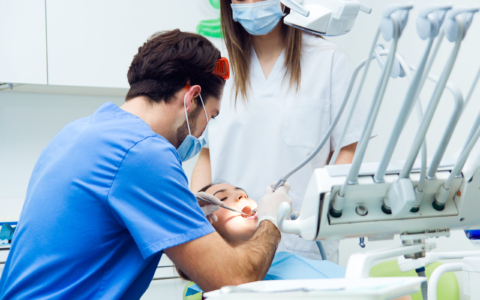
1. The dentist will examine the oral health condition, face, and jawbone structure to determine if metal braces can be practiced.
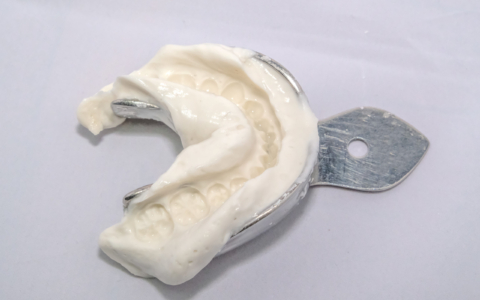
2. X-ray and make an impression to check the alignment of the upper and lower teeth and bone structure accurately.
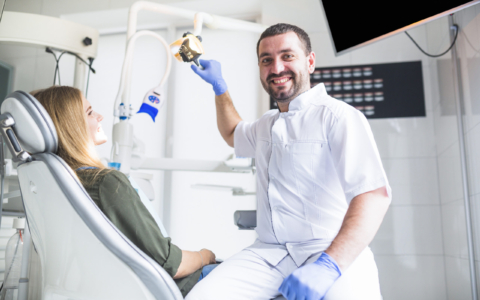
3. The dentist will make the teeth alignment treatment plan, clear the teeth by having dental scaling, tooth extraction, and fillings if applicable (by case).
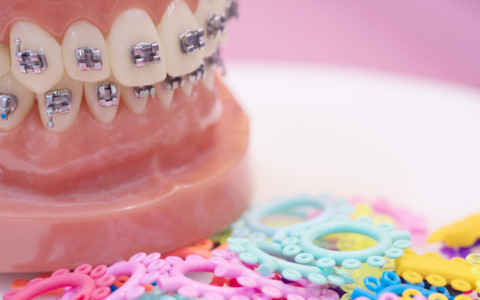
4. Attach the bracket to the teeth and ask for a follow-up appointment after 1 month.
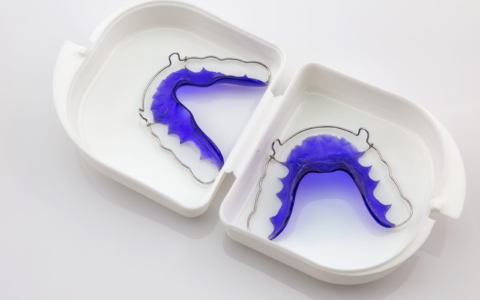
5. When the alignment process is over, patient will be required to wear the retainer as instructed by the dentist.
Metal Braces Duration
Metal braces usually take about 1-3 years depend on cases.
Lifespan of Metal Braces
It is essential to keep the alignment in place by wearing the retainer and taking good care of oral health.
Results of Metal Braces
- The teeth are aligned nicely
- Comfortable chewing and biting
- Increase confidence and improve personal development
- Improve overall oral health and reduce chances of oral diseases
Metal Braces Aftercare
- Brush the teeth with braces toothbrush, use dental floss and rinse with mouthwash
- Avoid chewing hard or sticky food
- The dentist may ask for an appointment every month or as instructed
- Wear the retainer as instructed by the dentist
- After the teeth alignment process is over, it is recommended to have an appointment with the dentist every 6 months to check the oral health
FAQ
A : Metal braces required a monthly checkup to adjust and replace the new braces. The dentist needs to check the alignment movements, plan the follow up treatment, change the O-ring and wire, and add/eliminate any additional composite, according to the dentist’s judgements and experiences.
A : Attaching the new metal braces on can be painful. The pain is depending on persons and can be over within 3-5 days. We recommend having only soft food and avoid chewing hard or sticky food.
A : We recommended to use dental wax to eliminate the irritation from the aligners. Take a small piece of wax and put on the bracket or wire. If the wire is too long or sharp, contact your dentist immediately.
A : Speech problems and drooling are not directly from the braces, but from the different feeling the braces have on the patient. Wearing braces can distract you mouth and lip, disturbing your pronunciation and proper mouth closure. The patient will get used to and these problems will eventually resolve after times but how long does it is usually depending on person.
A : After the alignment process over, the patient will need to wear a retainer to sustain the alignment. It is possible that the teeth will move to the prior positions. How long each patient needs to wear the retainer is by cases and according to the dentist.


 ไทย
ไทย